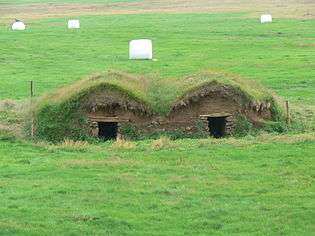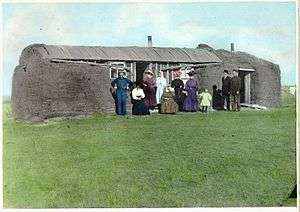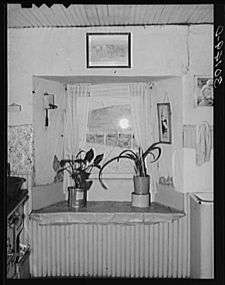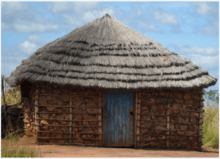Sod house




The sod house or "soddy"[1] was an often used successor to the log cabin during frontier settlement of the Great Plains of Canada and the United States. If the prairie lacked standard building materials such as wood or stone, sod from thickly-rooted prairie grass was abundant and could be used for construction.[2] Prairie grass had a much thicker, tougher root structure than modern landscaping grass.
Construction of a sod house involved cutting patches of sod in rectangles, often 2'×1'×6" (60×30×15 cm), and piling them into walls. Builders employed a variety of roofing methods. Sod houses accommodated normal doors and windows. The resulting structure was well-insulated and depending on the roof type inexpensive when compared to a wood frame house. However, sod houses required frequent maintenance and were often vulnerable to rain damage, especially if the roof was also primarily of sod. Stucco was sometimes used to protected the outer walls. Canvas or stucco often lined the interior walls.
Sod was also used to construct animal shelters, corrals and fences.
While the influence of the sod house cannot be overlooked, stone or timber was preferred when available. In addition, where railroads existed, framed houses and buildings were used extensively during the settlement period.
Notable sod houses
Sod houses that are individually notable and historic sites that include one or more sod houses or other sod structures include:
- Iceland
- Skagafjordur Folk Museum, turf/sod houses of the burstabær style in Glaumbær.
- Arbaer Folk Museum.
- Canada
- Addison Sod House, a Canadian National Historic Landmark building, in Saskatchewan.
- L'Anse aux Meadows, the site of the pioneering 10th-11th century CE Norse settlement near the northern tip of Newfoundland, has reconstructions of eight sod houses in their original locations, used for various purposes when built by Norse settlers there a millennium ago.
- United States
- Cottonwood Ranch, Sheridan County, Kansas. The ranch site, listed in the National Register of Historic Places (NRHP), included a sod stable.
- Dowse Sod House, near Comstock, Nebraska; NRHP-listed and operated as museum.
- Heman Gibbs Farmstead, Falcon Heights, Minnesota; the NRHP-listed site includes a replica of the original 1849 sod house.
- Jackson-Einspahr Sod House, Holstein, Nebraska, NRHP-listed.
- Leffingwell Camp Site, Flaxman Island, Alaska, listed on the U.S. National Register of Historic Places (NRHP).
- Minor Sod House, McDonald, Kansas, NRHP-listed.
- Page Soddy, Harper County, Oklahoma, NRHP-listed.
- Pioneer Sod House, Wheat Ridge, Colorado, NRHP-listed.
- Gustav Rohrich Sod House, Bellwood, Nebraska, NRHP-listed.
- Sod House (Cleo Springs, Oklahoma), also known as Marshall McCully Sod House, NRHP-listed.
- Sod House Ranch, Burns, Oregon, (does not include a sod house).
- Wallace W. Waterman Sod House, Big Springs, Nebraska, NRHP-listed.
See also
References
Further reading
| Wikimedia Commons has media related to Sod houses. |
- Two books by Solomon D. Butcher (1856–1927), Nebraska photographer of the homestead era, whose works include over 1,000 photos of sod houses: Pioneer History of Custer County and Short Sketches of Early Days in Nebraska (1901), and Sod Houses, or the Development of the Great American Plains (1904)
- Dick, Everett. The Sod-House Frontier, 1854-1890: A Social History of the Northern Plains from the Creation of Kansas and Nebraska to the Admission of the Dakotas. University of Nebraska.
